by Heidi Copeland | Aug 28, 2016
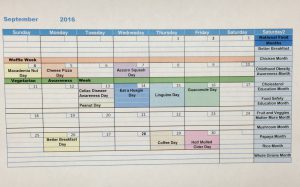
The University of Nebraska – Lincoln (UNL) provides a monthly Calendar of Food Days, Weeks, and Months plus provides resources for selected national food-themes. http://food.unl.edu/september-food-calendar
The month of September boasts a variety of activities using produce that can be grown somewhere in Florida. In fact, many crops are grown locally and are in season now. According to the Florida Department of Agriculture and Consumer Services (FDACS), avocados, carambolas, grapefruits, guavas, mushrooms, oranges, peanuts, and tangerines are Fresh From Florida® this month. http://www.freshfromflorida.com/content/download/16800/269959/09September.pdf In addition, local Red Hills Small Farm Alliance’s seasonal produce includes arugula, Asian greens, eggplant, garlic, okra, southern peas, peppers, radishes, summer and winter squash, figs, Muscadine grapes, pears, and persimmons.
It is easy to incorporate more fruits and vegetables into our diets. Try celebrating September with Vegetarian Awareness Week and consume any of the aforementioned produce, as well as peanuts on National Peanut Day, which is on September 13th.
Peanuts are actually legumes, and can easily fit into many meal plans. Additionally, they are considered a quality protein source for vegetarians. And, according to the Peanut Institute “While ‘nut’ is in their name, peanuts actually grow underground, as opposed to nuts like walnuts, almonds, etc. that grow on trees and are sometimes referred to as tree nuts”.
Peanuts, along with beans and peas, belong to the single plant family, Leguminosae. Leguminosae, commonly referred to as legumes are edible seeds that are enclosed in pods. These plants provide an excellent source of concentrated protein plus, peanuts are rich in vitamins, minerals and phytonutrients, and contain mostly good fats and fiber.
It is fun (and healthy) to experiment with local, fresh Florida produce anytime of the year, and why not have a delicious time this September celebrating a food recognition day, a food awareness week or even an entire month by incorporating Florida fresh foods into your daily, weekly, and monthly meals?
Below is a recipe for a savory peanut sauce, which is very versatile for vegetarian meals and meals with meat or fish. Some ideas for using peanut sauce include:
- Over noodles
- As a dipping sauce for vegetables or spring rolls
- As a baste or condiment for chicken, pork, beef , fish or tofu
- In a stir fry
- In a wrap
- In a slaw
INGREDIENTS
- ¾ cup creamy peanut butter
- ¼ cup rice vinegar
- ¼ cup water
- ⅓ cup reduced sodium tamari or reduced-sodium soy sauce
- 3 tablespoons honey or agave nectar
- 1½ teaspoons grated fresh ginger or ½ teaspoon ground ginger
- 1 to 2 medium cloves garlic, pressed or minced, to taste
- ¼ teaspoon red pepper flakes, plus more for sprinkling
- Optional garnishes: sprinkling of chopped roasted peanuts and additional red pepper flakes
- INSTRUCTIONS
- In a 2-cup liquid measuring cup or medium-sized mixing bowl, whisk together the ingredients until well blended. If your peanut butter is particularly thick, you may need to add a bit more water to thin out the mixture (adding water will mellow out the flavor as well).
- Feel free to adjust to taste here—for example, sometimes I want my sauce more savory and add another clove of garlic, or a little sweeter, so I add extra honey.
- If you’re serving the sauce as a party dip, transfer it to a serving bowl and sprinkle with chopped peanuts and red pepper flakes for some visual interest!
by Dorothy C. Lee | Jul 30, 2016
Do you consider buying groceries a real grind? A necessary evil? Well, it may never turn into a fun adventure for you, but there are some things you can do to make it easier on you and your budget.
Grocery shopping actually begins at home:
 Keep a note pad handy in the kitchen to make a list; when staple items are getting low, add them to your list so you won’t forget to replenish them. Then let your fingers do the walking through the grocery store ads to see which stores have the best buys on what you need.
Keep a note pad handy in the kitchen to make a list; when staple items are getting low, add them to your list so you won’t forget to replenish them. Then let your fingers do the walking through the grocery store ads to see which stores have the best buys on what you need.- You may want to plan menus around advertised specials and seasonal foods. It helps to have menus planned for the week so you can be sure to have all the necessary ingredients on hand.
- If you plan to use paper coupons, clip them to the list or use an electronic app. It is helpful to have the list organized according to the layout of the store to avoid backtracking for missed items.
- When shopping, buy non-perishables first and save refrigerated and frozen items for last. Make the grocery store your last stop if you are doing other errands. Once home, frozen and refrigerated items should be brought in and stored first.
- Finding the best buy can sometimes be a little tricky. Doing your homework with grocery ads is a good start for comparison shopping. When you get to the store, a little more detective work may be needed. If the store has it, learn to use unit pricing. This is the label on the shelf which gives not only the total price but also the price per unit (ounces, pounds, sheet, etc.). Buying larger sizes often saves money. However, this is not always the case, so use unit pricing or a calculator to check (divide the price by the number of ounces, pounds, etc.). Even if the larger size is cheaper per unit, be sure you can use all of it; if it spoils or can’t be stored, it is not a bargain. Can you divide foods into smaller portions and freeze some for later, or share with a friend?
- Another way to save is to compare national brands with store brands which are usually cheaper. The quality may or may not be the same, so try it once to see if it is acceptable. The nutritional value is usually the same.
- Buy the quality or form you need for the purpose. For example, don’t buy whole canned mushrooms then chop them into pieces if buying a container of already cut mushroom pieces is cheaper.
- Compare fresh, frozen and canned forms, especially for seasonal produce.
- Shop on a full stomach and alone if possible. Hunger and children often lead to impulse buying.
- Buy only the items on your list; anything else should be avoided unless it is a good buy on something you’re sure you will use.
- A larger portion of our “grocery” bill is actually for non-food items such as household cleaners, paper goods, personal grooming products, etc. Comparison shopping is important here too. Are there other types of stores where these products might be cheaper? Can these be purchased cheaper in bulk?
- Convenience foods are a part of today’s lifestyle. While they may save us time, they are usually more expensive than the homemade version. With some convenience foods you are paying for labor; grated cheese, cut up chicken, etc. With others we are paying for having ingredients packaged together; meat helpers, macaroni and cheese or vegetable sauces, etc. Compare time savings with the added cost. Are you paying for ingredients you may already have on the shelf or are easily purchased separately?
If you have questions about budgeting, shopping, menu planning or nutrition, contact your Family and Consumer Science Extension Agent.
For further information contact:
Dorothy C. Lee, C.F.C.S.
UF/IFAS Extension Escambia County
dclee@ufl.edu

by Marie Arick | Jul 29, 2016
![Sleeping_boy_at_desk_with_books[1]](https://nwdistrict.ifas.ufl.edu/fcs/files/2016/07/Sleeping_boy_at_desk_with_books1-300x199.jpg) Are your school kids getting enough sleep? With the new school year starting and routines being established, are things going smoothly? If you are sleep deprived, then the chances are your children may be sleep deprived as well. The following is an excerpt from the University of Michigan Health System:
Are your school kids getting enough sleep? With the new school year starting and routines being established, are things going smoothly? If you are sleep deprived, then the chances are your children may be sleep deprived as well. The following is an excerpt from the University of Michigan Health System:
School-aged children still need somewhere between 9 and 12 hours of sleep at night. At this age, kids usually start a trend toward becoming more and more sleep deprived. As the parents, you will need to help figure out how much sleep your child needs. Your child is getting the right amount of sleep if they:
- Can fall asleep within 15 to 30 minutes.
- Can wake up easily at the time they need to get up and don’t need you to keep bugging them to get up.
- Are awake and alert all day, and don’t need a nap during the day. Check with your child’s teacher and make sure your child is able to stay awake and alert during school.
In other words, if your child can go to bed, fall asleep easily, wake up easily, and not be tired during the day, then they’re probably getting enough sleep.
So, does your school-age child fit this bill? Obviously, the younger the child, generally, the more sleep they require. The amount of sleep required does vary from person to person, regardless of age. Are you aware that sleep deprivation is linked to poorer school outcomes as well as some behavioral and emotional problems? Adequate amounts of sleep for children (and adults, too) lead to healthier outcomes and better productivity.
Some simple steps to help your child to establish a better sleep routine is to set a bedtime and a ritual that cues the child that he/she is preparing for bed. Providing the appropriate environment to indicate to the child it is time to sleep is also important. Keeping the mood calm and relaxed can aid in allowing the child to unwind. Other hints include avoiding television one hour prior to bedtime, dim lights about two hours prior to bedtime, and limit or eliminate your child’s consumption of caffeinated beverages, such as soda and tea. The ideal bedroom setting is dark (a night light is ok), comfortably cool, quiet, and with few stuffed animals on the bed. If getting the bedtime ritual established is proving difficult, do not vary your waking times in the mornings, regardless if it is the weekend. Establishing and enforcing the waking time is easier to manage and will lend itself to eventually aiding in the establishment of a solid bedtime ritual. Teenagers and weekends will prove more challenging. But as parents, we are able to discuss sleep habits and the negative effects of sleep deprivation with them to allow them to participate more actively in improving their own sleep habits and become more responsible young adults along the way.
Remember, people in general need different amounts of sleep and the best way to determine if a child (or adult, for that matter) is sleep deprived is to ask the following questions the UMHS staff research has established:
- Does your child fall asleep in the car almost every time you drive with them?
- Do you have to wake your child up almost every morning?
- Does your child seem overtired, cranky, irritable, aggressive, over-emotional, hyperactive, or have trouble thinking during the day?
- On some nights, does your child “crash” much earlier than their usual bedtime?
A “yes” answer to any of the above can be an indication of sleep deprivation according to UMHS. It truly is a health benefit for your child to be well rested every day and this can be achieved with a good sleep routine.
Check out the University of Florida IFAS fact sheet to help address sleep needs for teens. Another great resource is the National Sleep Foundation.
Sweet dreams!

by Marie Arick | Jul 29, 2016
 As a parent or caregiver, understanding your child’s learning style can greatly aid when assisting with studies or homework.
As a parent or caregiver, understanding your child’s learning style can greatly aid when assisting with studies or homework.
Very simply, people process information differently and the learning process is different for each person. There are three main learning types: visual, auditory or kinesthetic. Understanding these learning types can help you to best support your child’s needs when they seek assistance.
Visual learners prefer having demonstrations, diagrams, handouts, videos, charts, and other types of pictorial items that assist them with comprehending the concept they are learning. Written instructions or lists are generally helpful for them as well. A simple cue that your child is a visual learner can be statements such as “can you show me” or “is there a picture I can see?”
Auditory learners learn by listening. They usually are the kids that can learn every word to a song after listening to it just once or twice. They will ask to discuss a subject or request you tell them about the subject.
Kinesthetic learners are the hands-on type. They utilize their senses and need to touch, hold, feel, or literally be hands-on with the learning experience to best gain their knowledge. And, yes, these are the learners that never seem to read the instructions first.
Another important fact is that most do actually learn using a variety of the above styles, but tend to prefer a certain method. Knowing and understanding a child’s preferred learning method can help you keep your child optimistic when it comes to learning. Be creative when possible. For example, if your child is a kinesthetic learner and is reluctant to study spelling words, use a baking sheet and some colored sugar and have them spell the words in the sugar to make it a creative and fun experience.
Ultimately, stay positive and understand that each person learns differently. Although your child’s preferred learning method may be different than yours, recognize their needs and provide support to aid them. Remember, teachers and school counselors can be a great resource, too.

by Amy Mullins, PhD, RDN | Jul 29, 2016
The Nutrition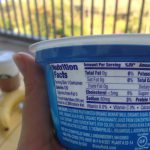 Facts label, seen on packaged bags, boxes, cans, etc., is the consumer information gateway to making healthy choices for ourselves and our families. But let’s face it, for many Americans, interpreting the Nutrition Facts label can be downright confusing, at times, essentially clouding our decision-making abilities.
Facts label, seen on packaged bags, boxes, cans, etc., is the consumer information gateway to making healthy choices for ourselves and our families. But let’s face it, for many Americans, interpreting the Nutrition Facts label can be downright confusing, at times, essentially clouding our decision-making abilities.
Making informed decisions about what you eat every day is an important step in maintaining good nutrition, reducing your risk for heart disease, and keeping your weight in a healthy range. After more than 20 years, the FDA has finalized an improved version of the old label to be in full effect nationwide by mid-2018. First Lady Michelle Obama states, “This is going to make a real difference in providing families across the country the information they need to make healthy choices.”
Key Changes to Look For on the New Label: 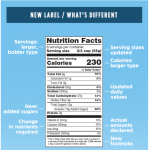
- Added Sugars – One of the more important changes is based on data that shows the difficulty in meeting nutrient needs while staying within calorie limits if you consume more than 10 percent of your total daily calories from added sugar.
- Specific Vitamins & Minerals – Vitamin D and potassium will be required on the label. Calcium and iron will continue to be required. Vitamins A and C will no longer be required but can be included on a voluntary basis.
- Daily Values (%) – Updates on sodium, dietary fiber, and Vitamin D.
- Serving Sizes – Now reflect actual common amounts consumed, not recommended amounts. For example, a serving size for soda previously was 8oz. but is now 12oz.
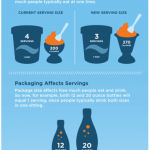 Package Size – Calories and other nutrients will be required to be labeled as one serving because people typically consume it in one sitting.
Package Size – Calories and other nutrients will be required to be labeled as one serving because people typically consume it in one sitting.
- New Format – Highlighting “Calories,” “Servings per container,” and the “Serving size” declaration by increasing the type size and placing the number of calories and the “Serving size” declaration in bold type as well as changing the footnote to better explain the percent Daily Value.
The new label regulations apply to packaged foods except certain meat, poultry, and processed egg products, which are regulated by the U.S. Department of Agriculture’s Food Safety and Inspection Service. To learn more about these important changes, visit the Food and Drug Administration website and read Changes to the Nutrition Facts Label.

by Heidi Copeland | Jul 29, 2016
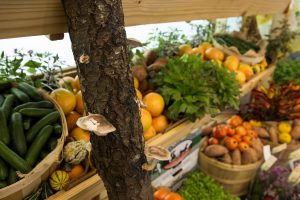 As much as I wanted to write about Sneak Some Zucchini Onto Your Neighbors’ Porch Day, celebrated on August 8, it was difficult because zucchini, a summer squash, takes a two-month hiatus during July and August, the warmest Florida summer months. Nevertheless, there is quite a variety of produce growing locally (within 100 miles) of this Capital City and it is amazing! While the Florida state produce calendar boasts eight “Fresh From Florida” seasonal products, local growers produce almost double that amount. Nearby, arugula, sweet corn, eggplant, garlic, okra, southern peas, peppers of all kinds, winter squash, cantaloupe, figs, Muscadine grapes, pears, and watermelon are generally available here, now. As popular as shopping and eating locally are becoming, it is important to know what grows in this area and when it is ready, as nothing beats fresh produce.
As much as I wanted to write about Sneak Some Zucchini Onto Your Neighbors’ Porch Day, celebrated on August 8, it was difficult because zucchini, a summer squash, takes a two-month hiatus during July and August, the warmest Florida summer months. Nevertheless, there is quite a variety of produce growing locally (within 100 miles) of this Capital City and it is amazing! While the Florida state produce calendar boasts eight “Fresh From Florida” seasonal products, local growers produce almost double that amount. Nearby, arugula, sweet corn, eggplant, garlic, okra, southern peas, peppers of all kinds, winter squash, cantaloupe, figs, Muscadine grapes, pears, and watermelon are generally available here, now. As popular as shopping and eating locally are becoming, it is important to know what grows in this area and when it is ready, as nothing beats fresh produce.
Perhaps you are interested in saving some of the August harvest. Nearly all vegetables can be frozen, provided a few simple procedures are followed. Freezing does not sterilize foods like pressure canning does. However, freezing does delay the growth of microorganisms and slows down chemical changes that affect vegetable quality; there also will be textural changes during freezing.
Blanching – scalding vegetables in boiling water for a short period of time – is an easy process to inactivate the enzymes in the vegetable skin and to destroy microorganisms on the vegetable surface. Plus, blanching reduces the vegetable in size a bit so it does not take up as much room in the freezer. Blanching time is crucial and varies with vegetable and size.
Cooling is critical, too. Vegetables should be cooled quickly and thoroughly to stop the cooking process. To cool, plunge the vegetables immediately into a large quantity of cold water or ice water for about the same amount of time as blanching. Drain vegetables thoroughly after cooling; promptly and properly package, label, and place in the freezer. Freezing is an easy and convenient food preservation method that allows you to enjoy food in the future.
If you are looking for something that tastes good and is good for you, try a vegetable medley with all the vegetables you can freeze. A medley mixes fresh, frozen, or a combination of both vegetables for a dish that takes a short time to prepare, can be eaten hot or cold, frozen for future use, or even added to a stock for a flavorful vegetable soup.
If you are one of the lucky ones gifted with an abundance of produce from the farm, garden, or friends, all of the vegetable ingredients in the recipe below can be frozen as single ingredients or in pre-measured amounts to help you quickly whip up a batch of summer fare.
Summer squash, like zucchini and crookneck squash, might be taking a break during these dog days of summer, but soon they will be fruitful again, proliferating by the bushel basket.
By using the aforementioned techniques, try saving some of what is in season today to add to what will be growing shortly!
VEGETABLE MEDLEY
Ingredients
1/4 cup olive oil (or less)
1 cup onion (diced – does not need blanching)
2 garlic cloves (smashed, minced – do not need blanching)
2 cups bell pepper (red, green or yellow, diced – does not need blanching)
2 cups zucchini (1/2 inch slices; blanch 3 minutes)
2 cups Crookneck (1/2 inch slices; blanch 3 minutes)
3 cups lima beans (blanch for 2 to 4 minutes)
3 cups corn kernels (fresh: blanch whole ear for 4 minutes before removing from the cob)
2 tablespoons favorite herb (parsley, basil, rosemary…even mint, coarsely chopped)
Directions
- In a skillet over medium-high heat, add oil.
- Add onion; cook until translucent (2 minutes). Add garlic, bell peppers, zucchini, squash, lima beans, and corn.
- Season as desired; cook, stirring, until vegetables are tender (10 minutes). Stir in seasoning and serve warm or cold or even freeze to use at a later date.
For more information about proper freezing techniques, see University of Nebraska-Lincoln, http://food.unl.edu/freezing.




![Sleeping_boy_at_desk_with_books[1]](https://nwdistrict.ifas.ufl.edu/fcs/files/2016/07/Sleeping_boy_at_desk_with_books1-300x199.jpg)







